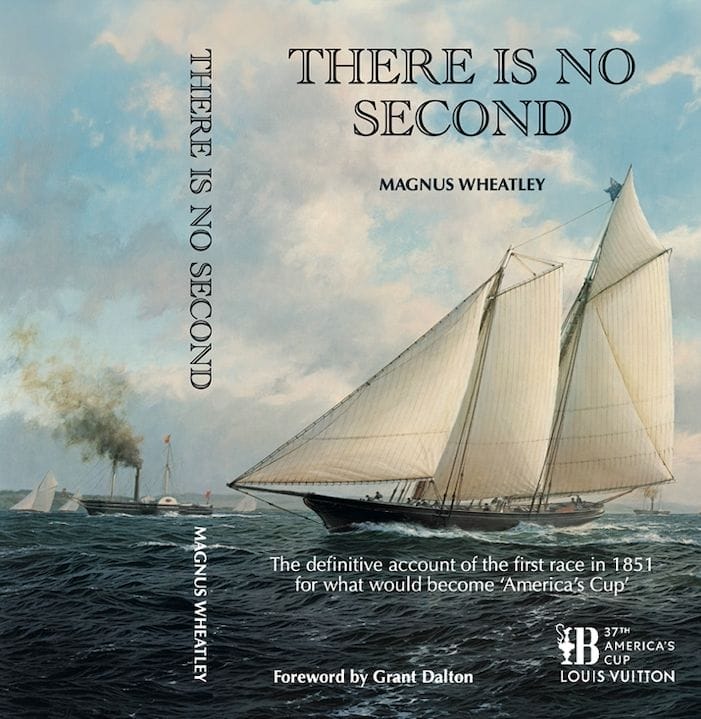
Myths of America’s Cup debunked in new book: There Is No Second

Seasoned British America’s Cup journalist Magnus Wheatley explains his fascination with the America’s Cup and the itch that compelled him to debunk the origin myths of ‘the most famous race in history’.
Like many of my generation, the America’s Cups of 1983 and 1987 seared into the conscious and piqued an interest that became an obsession. Peel back the onion of this event and the stories just leap from the page, but a background in journalism led me to start questioning the accounts that I was reading, mainly American, where the history felt almost too good to be true.
The most pertinent were the accounts of that first race around the Isle of Wight in 1851 for a trophy, purchased on-spec from the Panton Street showroom of R&S Garrard in London by the colourful Marquess of Anglesey in 1848. That would become the literal, and original, America’s Cup.
I thought I knew the story and I thought I knew it well. The yacht America came over from New York, trounced the British fleet with a pilot boat design and flat-cut sails, and stole back across the Atlantic having given John Bull and his previously all-conquering armada, a bloody nose. The truth however was much more nuanced and the backdrop as to why American writers of the day celebrated so hard was something worth investigating.
However, where the research for the book started was a blind obsession with the source of the title of I wanted to use: There is no Second. Supposedly this was uttered to Queen Victoria as she sat on the port aft-deck of the Royal steamship Victoria & Albert by a signal-master, but his name was never recorded.
That triggered an interest and the most fascinating part of the research involving first the Royal Archives (housed at Windsor Castle), then the Naval Archives and finally the National Archives (which explore 1,000 years of UK history).
Having run into brick walls regarding ship musters, the breakthrough came when I discovered that sailors in the mid-19th century were not paid their wages directly for fear of dockside ‘consumption’. Instead, the sailors nominated a family member to receive the monies and the record of these transactions with dates, times, rank, service numbers and ship associations were recorded in sealed documents that had lain unopened in Kew at the National Archives for 173 years.
Breaking the seal, discovering the name of the Yeoman of the Signal and revealing all, remains a wonderful memory in the story of this book. A small hand of history was on my shoulder.
With the cornerstone of the book secured, the remainder became a pleasure and as many authors say, ‘wrote itself.’ The cast of characters from the swashbuckling war hero of the Battle of Waterloo Lord Anglesey through to the Earl of Wilton of the Royal Yacht Club and John Cox Stevens of the New York Yacht Club . . . even to the book-end character of James Lloyd Asbury, just enthralled.
The research, through extensive work at the John Hopkins University, took me deep into the socio-political scene around Prince Albert’s Great Exhibition of 1851 and the poor showing by the American delegation. That came from over-booking space and delivering a paltry show which included a Charles Goodyear rubber dinghy, Colt pistols, some small locks, a cotton-engine, a sewing machine, dental implants and Virginian honey . . . hardly a showcase of the New World in comparison to the lavish Indian or British sections that were stuffed with curiosities, luxury and advanced farming and steam machinery of the Victorian age.
My research trawled through the satirical London magazines and newspapers of the day – and it’s there where the penny dropped. The American writers were so keen to write-up the success of the America in the race because, in essence, they had nothing positive that summer to write about. The 1851 exhibition had been a disaster and the American were getting negative press from the mainstream newspapers and the satirical magazines.
When America won, they could latch onto a positive narrative and books like the The Lawson History of the America’s Cup and plenty of accounts in magazines in the US peddled a narrative of utter dominance. They were incorrect as the book explains, but have been repeated ever since.

To write anything described as ‘the definitive’ comes with an inherent pressure but There is no Second debunks and de-mystifies the most famous race in history. It’s out now and available worldwide on Amazon (or search Magnus Wheatley, There Is No Second).
And for those not of my generation? 1983 saw the Australians end the American’s 132 year possession of the cup with the introduction of a winged keel. And in 1987, the big winds and seas of Fremantle, Perth in Western Australia afforded a spectacular and dramatic America’s Cup.
The post Myths of America’s Cup debunked in new book: There Is No Second appeared first on Marine Industry News.
